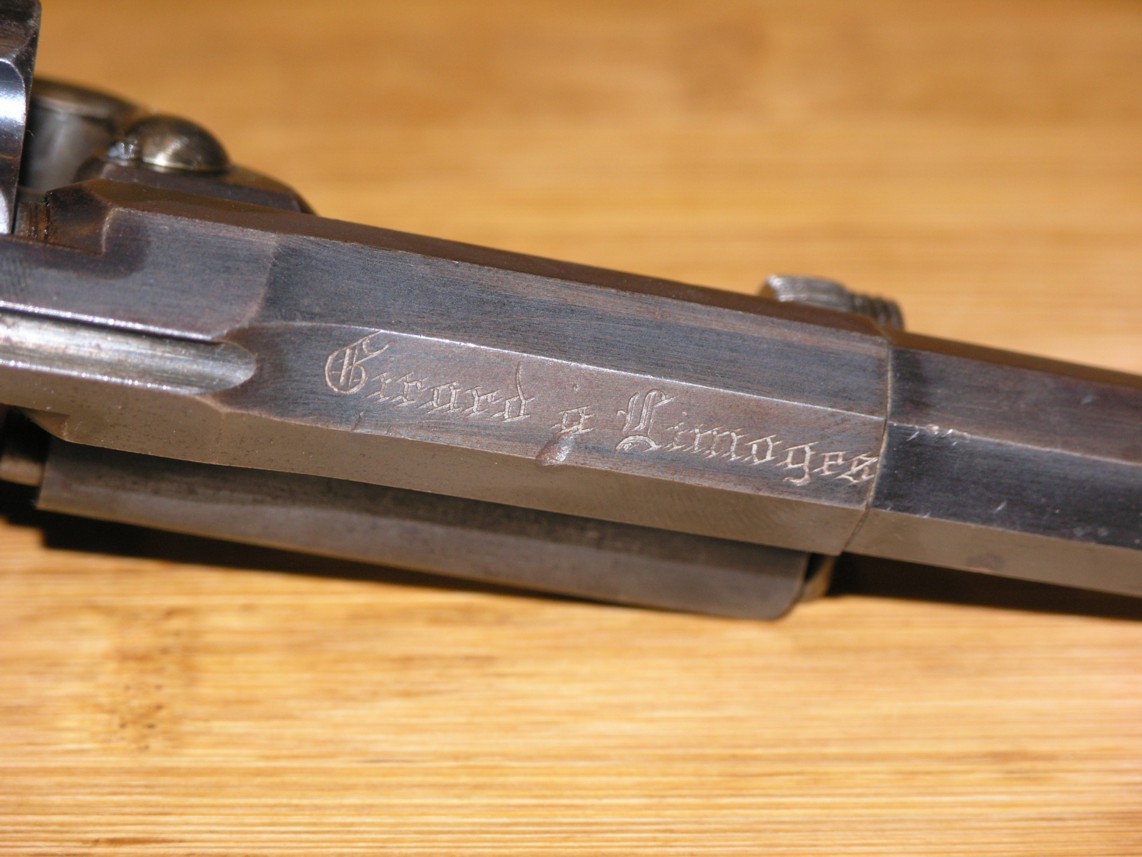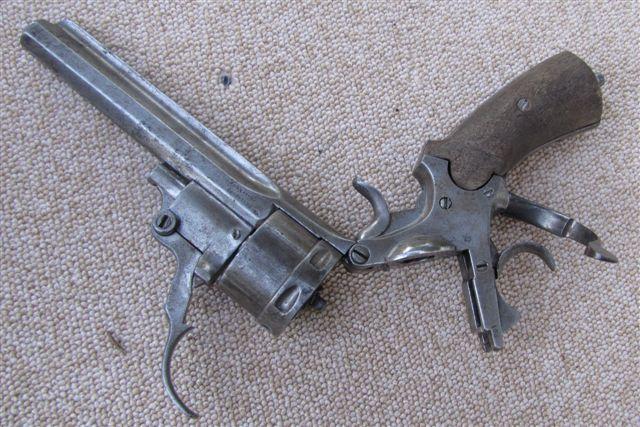Some of the most beautiful work of this craftsman, and many others, are in this book “Liège Gunmakers through their Work. 1800 - 1950”.
For more detail see: LIEGE GUNMAKERS
Fagnus Alexandre
Here is a classic revolver of
Alexandre
Fagnus et Cie under patent 041 092 dated 15
December 1876.
This
weapon has already been extensively mentioned on the site, both among the
Identified Artisans and in the Exceptional Private Collection.
However,
he has no hallmark from the Liège proofhouse, but the German hallmark U under
two crowns (three times). According to the German law of 1891, this means that
the weapon has undergone two tests.
This is a
rather late production.
The
calibre is perhaps the 450 since the French 11 mm “floats” in the cylinder.
GP with the help of DZ and the whole team.







Fagnus & Cie
A luxury
Fagnus
with gold and silver inserts.






Fagnus & Cie
Here's a
revolver Fagnus & Co.
Long time
called "Maquaire" by the French, but this name is that of the French importer
and not the Belgian manufacturer!
All those
seen so far are marked "Fagnus" or "Fagnus bté", but this one has on the butt
skeleton the mark "Fagnus & Cie Bté".
Girard in
Limoges is the French dealer of course!
AD























Fagnus
Here is a pinfire revolver of unspecified caliber, marked Fagnus Breveté. It was sold by Liverpool gunsmiths Edward and George Higham of Liverpool.
Fagnus
is well known for its generally much better quality production.
We have here a production of the simplest, closed frame. The socket ejector rod is screwed into the stock.
There's no Liège stamp.
However, I seem to see a tiny punch on the barrel.
In
principle, there should be one in every chamber.
I don't see how this ultra-simple, classic revolver could possibly be a patent. It is more than likely to take the meaning Patented in the sense that Fagnus was a licensed gunsmith.
GP with the help of HPH.





Alexandre Fagnus
Extremely rare rifle revolver with removable stick signed A. FAGNUS.
Revolver “A chains” gauges 12mm pinfire.
The barrel (striped) is in a new state; the weapon probably never shoot!!!
Jean-Michel RIOMET
A. Fagnus & Cie
The weapon
It is about a revolver with central percussion, with barrel and cylinder raising with extractor. The lock is with simple and double action. The cylinder is with 6 rooms and the barrel with 8 sides surmounted by a band while the interior is with 7 concentric stripes.
The trigger guard is divided into two, one makes carry out a quarter-of-turn to the posterior part, action which puts the hammer at the first notch. One can draw the former part upwards, initially the barrel and the cylinder is raised. By accentuating traction, it makes the action leverage for the star extractor which leaves its housing then.
The plates are in walnut smooth reserves by a transverse screw and 2 rivet washers.
Punches
Obviously sudden weapon an important sandpapering because the punches are almost unobtrusive.
They are the punches of the proofhouse of tests of Liege, namely:
ELG on star in a crowned oval: final acceptance, of use of 1846 to 1893.
L spangled: countermark of the controller post 1877.
Marks
Only mark CAST STEEL is still quite visible. It indicates to my opinion that the weapon was manufactured out of steel cast iron.
The weapon in question is an invention of FAGNUS Alexandre, arms manufacturer of Liège. It deposited for this weapon patent 28332 of the 22.12.70 and two patents of improvements n°28420 of the 23.01.71 and 28560 of the 14.03.71.
GG
On sale at "André Nowak"
Photos Littlegun


In connection with
mark 
In the file FAGNUS Alexandre, a question remain open, the significance of mark C&D in an oval lying?
However we know (almost) all that FAGNUS created a company with CLEMENT Charles, which leaves me think that CLEMENT probably manufactured revolvers for FAGNUS.
I thus advance the assumption that C&D in an oval means CLEMENT and DOLMAN, this last patronym pertaining to the wife CLEMENT born DOLMAN J.
The latter seemed well with the fact of the company since with the death of Charles, it is it which ensured the continuation of the business with LOISELET Victor.
GG
A. Fagnus & Cie
Revolver Fagnus, 6 shots, calibre .450.
Revolver with barrel and cylinder rising with extractor.
The trigger guard is divided into two: One makes carry out a quarter of tower to the posterior part, action which puts the hammer at the first notch. One can draw the former part upwards, initially the barrel and the cylinder is raised. By accentuating traction, it makes action leverage for the star extractor which leaves its housing then. Plates in walnut (?) smooth, ring of cap (lack).
Patent of improvement 28560 of the 14/03/1871 in the name of A. Fagnus & Co
Alexandre FAGNUS, manufacturer of weapons, one finds it with the liking of the documents with the following addresses, always in Liege: street of Célestines, 9 (1863/1867), street Maghin, 19, street Cherished (1880) street Jolivet, 31 (1886), street of the Arms manufacturers, 24 (1888).
Punches
V crowned: countermark of the controller of the 30/12/1853 to the 26/01/1877.
ELG on star in an oval: final acceptance of the 08/09/1846 to the 10/07/1893.
Markings
Crucible cast steel.
261?: serial number.
HPH






S.A. Alexandre FAGNUS & Cie
The weapon
It is about a revolver with box frame, central percussion and lock with simple and double action.
The cylinder is grooved and contains 6 rooms of gauge .450.
The steel barrel is hexagonal with front sight in half-moon.
The weapon is provided on the left side with a wrench offset and swivelling allowing the opening with the plate with protection giving access to the internal mechanism. The left grips can also be withdrawn without tool. The parts of the mechanism are numbered (from 1 to 5) to facilitate disassembling and the reassembly.
A rod of unloading is placed on the right side of the gun and is maintained by the head knurled and swivelling.
The loading is done spoke right side door dropping towards the back thanks to an internal spring.
Punches
The weapon carries the punches of the proofhouse of Liege, namely:
ELG on star in a vertical oval: final acceptance, of use of 1846 to 1893.
M spangled: countermark of the controller post 1877.
This weapon was thus manufactured between 1876 and 1893.
The inventor
This weapon is often indicated by French as being a revolver MAQUAIRE, it of it is not nothing.
Amédée MAQUAIRE was a Parisian, directing wholesaler general agency of the sewing machines MAQUAIRE, which presented this revolver (at the request of A. FAGNUS?) at the commission of Vincennes in the hope which it becomes lawful. A government order being a dedication.
The true inventor is Alexandre FAGNUS, manufacturer of weapons street of Célestines, 9 in Liege (1861/1868) which deposited 7 Belgian patents concerning of the revolvers of which the patent the 15.12.1876 for the present weapon.
It creates then a company called FAGNUS Alexandre & Co (1870/1879) street Jolivet, 31 in LIEGE, then the company becomes FAGNUS & CLEMENT (1879/1883). The firm is then taken again by CLEMENT, Charles.
FAGNUS will still create a named company FAGNUS Alexandre & NOSSENT Servais de1887 at 1890, company taken again in 1890 by NOSSENT Servais.
GG

Fagnus "BABY"
Calibre .320
Many thanks to Michel for the nice pictures.







S.A. Alexandre FAGNUS & Cie
It is about a revolver with central percussion and framework closed “tip up”.
The barrel and the cylinder with extractor are raised upwards.
The trigger guard is divided into two: one makes carry out a quarter of tower to the posterior part, action putting the hammer at the first notch. One can draw the former part upwards, initially the barrel and the cylinder is raised. By accentuating traction, it makes action leverage for the star extractor which leaves its housing then.
The barrel with 8 sides carries 7 concentric stripes and is surmounted by a band.
The lock is with simple and double action.
The plates are in drowning squared with ring of cap and screw pivot.
The weapon carries the punches of the proofhouse of Liege, namely:
ELG on star in an oval: acceptance, of use of 1846 to 1893.
P reversed (or q) under star: countermark of the controller post 1877.
Another mark:
CASTSTEEL: mark meaning that it is about crucible cast steel.
Your weapon is a FAGNUS manufactured by SA Alexandre FAGNUS & Co in Liege.
This weapon was the subject of patent n° 28332 of the 22.12.1870 and two patent of improvements n° 28420 of the 23.01.1871 and 28560 of the 14.03.1871.
GG











Fagnus


Another


A. Fagnus et Cie
Rue Maghien, 19 to Liège.
Then Rue Chéri, 20b in partnership with Charles CLEMENT and Rue des armuriers, 24 to Liège in 1880.
Registered voter with the Belgian bench of test of 1870 to 1879, then FAGNUS & CLEMENT of 1879 to 1883. A this date the company is taken again by CLEMENT C (manufactured famous revolver MAQUAIRE and revolver FAGNUS with pins + chain holding the barrel.
Revolver FAGNUS is often and incorrectly called "MAQUAIRE" of the name of a Director of the deposit of PARIS which represented the interests of house A. FAGNUS & Co, Rue Jonruelle, 19-21 to Liège. This weapon was adopted in cal. 450 by the Danish officers in 1880.Ce civil revolver with military vocation seems to be inspired by 1873 French. Its turntable is with simple and double action and its mechanism are accessible by the left where a plate of covering maintained in place by a key, swivels on an axis once the operated key. All the interior parts are numbered. The ebony plates-grip are finely squared.
Manufacture out of crucible cast steel is excellent.
In gauge 380 the weapon is length a 215 mm and weighs 850 gr.. It carries the following inscriptions on the left side "Acier fondu " and on the barrel mark ELG in an oval and N under a star (mark of the controller of the Bench test. Liège).
GG

Fagnus
This weapon was largely evoked on the site! There thus remains the famous mark C & D in an oval lying!
I deliver to you an extract of a very beautiful article carried out by J.P. BASTIE (G of A n° 264) and which says:
“These punches already made run much ink without anybody never really could identify them! These punches (JN - ES - WR - JL - MB in a cartouche) are often allotted wrongly to famous arms manufacturers and are in fact only the mark of suppliers and forgotten workmen who contributed to the production of Fagnus!)
In fact, I read again Who’s who arms manufacture of Liège without finding an association of arms manufacturers “C & D” which could have corresponded to the dates of manufacture of Fagnus is the last quarter of the 19th century and perhaps until 1914.
GG
Another Fagnus







Dear Alain,
On the English version of the Fagnus page the pistol is described as having "simple and double action", which I take to mean "single and double action". That was my expectation, so, when I discovered that I could not lock the hammer back to fire it single action I feared that it might be broken.
However, upon opening the side plate, it appeared that there never was a provision to lock the hammer. In the picture attached, compare the smooth hammer bar of the Fagnus on the right to the notched bar of the Rast and Gasser on the left. This construction of the hammer bar is necessary to lock the hammer and fire single action.
Best regards,
Roger
